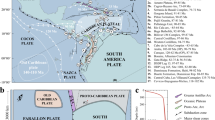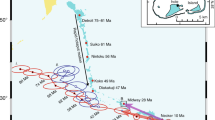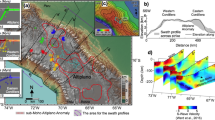Abstract
The cause of the Laramide phase of mountain building remains uncertain1. Conceptual models implicate the subduction of either ocean ridges2 or conjugates of the buoyant Hess3 or Shatsky4 oceanic plateaux. Independent verification of these models has remained elusive, because the putative ridges or plateaux are no longer at the Earth’s surface. Inverse convection models5 have identified two prominent seismic anomalies on the recovered Farallon plate. Here we combine inverse convection models with reconstructions of plate motions, to show that these seismic anomalies coincide palaeogeographically with the restored positions of the Shatsky and Hess conjugate plateaux as they subducted beneath North America. Specifically, the distribution of Laramide crustal shortening events6 tracked the passage of the Shatsky conjugate beneath North America, whereas the effects of the Hess conjugate subduction were restricted to the northern Mexico foreland belt7. We propose that continued subduction caused the oceanic crust to undergo the basalt–eclogite phase transformation, during which the Shatsky conjugate lost its extra buoyancy and was effectively removed. Increases in slab density and coupling between the overriding and subducting plates initially dragged the surface downward, followed by regional-scale surface rebound. We conclude that Laramide uplift resulted from the removal, rather than emplacement, of the Shatsky conjugate.
This is a preview of subscription content, access via your institution
Access options
Subscribe to this journal
Receive 12 print issues and online access
$259.00 per year
only $21.58 per issue
Buy this article
- Purchase on Springer Link
- Instant access to full article PDF
Prices may be subject to local taxes which are calculated during checkout




Similar content being viewed by others
References
English, J. & Johnston, S. The Laramide orogeny: What were the driving forces? Int. Geol. Rev. 46, 833–838 (2004).
Henderson, L. J., Gordon, R. G. & Engebretson, D. C. Mesozoic aseismic ridges on the Farallon plate and southward migration of shallow subduction during the Laramide orogeny. Tectonics 3, 121–132 (1984).
Livaccari, R. F., Burke, K. & Sengor, A. M. C. Was the Laramide orogeny related to subduction of an oceanic plateau? Nature 289, 276–278 (1981).
Tarduno, J. A., McWilliams, M., Debiche, M. G., Sliter, W. V. & Blake, M. C. Jr Franciscan Complex Calera limestones: Accreted remnants of Farallon Plate oceanic plateaus. Nature 317, 345–347 (1985).
Liu, L., Spasojevic, S. & Gurnis, M. Reconstructing Farallon plate subduction beneath North America back to the Late Cretaceous. Science 322, 934–938 (2008).
Saleeby, J. Segmentation of the Laramide slab—evidence from the southern Sierra Nevada region. Geol. Soc. Am. Bull. 115, 655–668 (2003).
Campa, M.-F. in Tectonostratigraphic Terranes of the Circum-Pacific Region (ed. Howell, D. G.) 299–313 (Earth Sci. Ser., Circum-Pacific Council for Energy and Mineral Resources, 1985).
Liu, L. & Gurnis, M. Simultaneous inversion of mantle properties and initial conditions using an adjoint of mantle convection. J. Geophys. Res. 113, B08405 (2008).
Müller, R. D. et al. Age, spreading rates, and spreading asymmetry of the world’s ocean crust. Geochem. Geophys. Geosyst. 9, Q04006 (2008).
Grand, S. P. Mantle shear-wave tomography and the fate of subducted slabs. Phil. Trans. R. Soc. Lond. A 360, 2475–2491 (2002).
DeCelles, P. Late Jurassic to Eocene evolution of the Cordilleran thrust belt and foreland basin system, western USA. Am. J. Sci. 304, 105–168 (2004).
Saleeby, J., Farley, K. A., Kistler, R. W. & Fleck, R. J. Thermal evolution and exhumation of deep-level batholithic exposures, southernmost Sierra Nevada, California. Spec. Pap. Geol. Soc. Am. 419, 39–66 (2007).
Ducea, M. N., Kidder, S., Chesley, J. T. & Saleeby, J. Tectonic underplating of trench sediments beneath magmatic arcs: The central California example. Int. Geol. Rev. 51, 1–26 (2009).
Nadin, E. S. & Saleeby, J. B. in Ophiolites, Arcs, and Batholiths (eds Wright, J. E., & Shervais, J. W.) Spec. Pap. Geol. Soc. Am. 438, 429–453 (2008).
George, P. G. & Dokka, R. K. Major Late Cretaceous cooling events in the eastern Peninsular Ranges, California, and their implications for Cordilleran tectonics. Geol. Soc. Am. Bull. 106, 903–914 (1994).
Burchfiel, B., Cowan, D. & Davis, G. in The Cordilleran Orogen: Conterminous US (eds Burchfiel, B. C. et al.) 407–479 (GSA, 1992).
Ferrari, L., Valencia-Moreno, M. & Bryan, S. Magmatism and tectonics of the Sierra Madre Occidental and its relation with the evolution of the western margin of North America. Spec. Pap. Geol. Soc. Am. 422, 1–39 (2007).
Karlstrom, K. E. & Daniel, C. G. Restoration of Laramide right-lateral strike slip in northern New Mexico by using Proterozoic piercing points: Tectonic implications from the Proterozoic to the Cenozoic. Geology 21, 1139–1142 (1993).
Druschke, P. et al. Synconvergent surface-breaking normal faults of late Cretaceous age within the Sevier hinterland, east-central Nevada. Geology 37, 447–450 (2009).
Flowers, R. M., Wernicke, B. P. & Farley, K. A. Unroofing, incision, and uplift history of the southwestern Colorado Plateau from apatite (U–Th)/He thermochronometry. Geol. Soc. Am. Bull. 120, 571–587 (2008).
Manea, V. & Gurnis, M. Subduction zone evolution and low viscosity wedges and channels. Earth Planet. Sci. Lett. 264, 22–45 (2007).
Ringwood, A. E. & Green, D. H. An experimental investigation of the gabbro-eclogite transformation and some geophysical implications. Tectonophysics 3, 383–427 (1966).
Guscher, M.-A., Olivet, J.-L., Aslanianb, D., Eissen, J.-P. & Mauryd, R. The ‘lost Inca Plateau’: Cause of flat subduction beneath Peru? Earth Planet. Sci. Lett. 171, 335–341 (1999).
Li, C., van der Hilst, R. D., Engdahl, E. R. & Burdick, S. A new global model for P wave speed variations in Earth’s mantle. Geochem. Geophys. Geosyst. 9, Q05018 (2008).
Hirose, K., Fei, Y., Ma, Y. & Mao, H.-K. The fate of subducted basaltic crust in the Earth’s lower mantle. Nature 397, 53–56 (1999).
Carpenter, M. A., Hemley, R. J. & Mao, H.-K. High-pressure elasticity of stishovite and the P42/mnm⇔Pnnm phase transition. J. Geophys. Res. 105, 10807–10816 (2000).
Lakshtanov, D. L. et al. The post-stishovite phase transition in hydrous alumina-bearing SiO2 in the lower mantle of the earth. Proc. Natl Acad. Sci. USA 104, 13588–13590 (2007).
Cammarano, F., Goes, S., Vacher, P. & Giardini, D. Inferring upper-mantle temperatures from seismic velocities. Phys. Earth Planet. Int. 138, 197–222 (2003).
Sun, D., Helmberger, D., Ni, S. & Bower, D. Direct measures of lateral velocity variation in the deep Earth. J. Geophys. Res. 114, B05303 (2009).
Müller, R. D., Sdrolias, M., Gaina, C., Steinberger, B. & Heine, C. Long-term sea-level fluctuations driven by ocean basin dynamics. Science 319, 1357–1362 (2008).
Acknowledgements
We thank D. Helmberger, D. Anderson, P. DeCelles and K. Karlstrom for helpful discussions and P. DeCelles for a helpful review. This represents Contribution number 10026 of the Division of Geological and Planetary Sciences and 102 of the Tectonics Observatory, Caltech. At Caltech this work has been supported by the National Science Foundation (EAR-0739071 and EAR-0810303) and through the Tectonics Observatory by the Gordon and Betty Moore Foundation.
Author information
Authors and Affiliations
Contributions
L.L. and M.G. designed the whole workflow and carried out the inverse convection model, M.S. and R.D.M. carried out the plate reconstruction, J.S. worked on the geological interpretation and J.M.J. provided mineral physics analysis. All authors participated in preparing the paper.
Corresponding author
Ethics declarations
Competing interests
The authors declare no competing financial interests.
Supplementary information
Supplementary Information
Supplementary Information (PDF 613 kb)
Rights and permissions
About this article
Cite this article
Liu, L., Gurnis, M., Seton, M. et al. The role of oceanic plateau subduction in the Laramide orogeny. Nature Geosci 3, 353–357 (2010). https://doi.org/10.1038/ngeo829
Received:
Accepted:
Published:
Issue Date:
DOI: https://doi.org/10.1038/ngeo829
This article is cited by
-
Magmatic surge requires two-stage model for the Laramide orogeny
Nature Communications (2023)
-
Kimberlite eruptions driven by slab flux and subduction angle
Scientific Reports (2023)
-
Secular craton evolution due to cyclic deformation of underlying dense mantle lithosphere
Nature Geoscience (2023)
-
Magmatic source, petrogenesis, and tectonic setting of the Concepción del Oro Igneous Complex: a geochemical and isotopic (Rb–Sr and Sm–Nd) study of a late complex of the Cretaceous–Eocene Mexican Magmatic Arc
International Journal of Earth Sciences (2023)
-
Floodplain evolution during the early Paleogene within the Piceance Creek Basin, northwest Colorado, U.S.A
Journal of Sedimentary Environments (2022)



